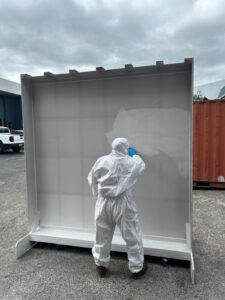Discovering smoke damage in your home can be both heartbreaking and overwhelming. Whether it’s from a small kitchen fire, an electrical mishap, or an unfortunate larger incident, the aftermath leaves behind stubborn odours, soot stains, and health hazards that many homeowners underestimate.
If you’re tempted to tackle smoke damage on your own, it’s vital to know which tasks are safe for a DIY approach — and which are best left to trained professionals. In this guide, we’ll break down practical smoke damage cleaning tips, what you can realistically handle yourself, and when it’s time to call in the experts.
Understand the Different Types of Smoke Damage
Before grabbing a sponge or scrubbing brush, it helps to recognise that not all smoke damage is the same. The way you clean it depends heavily on what burned and how long it smouldered.
Common types include:
- Dry smoke: Fast-burning fires from paper or wood, leaving light, powdery soot.
- Wet smoke: Slow-burning, smouldering fires (think rubber or plastics) creating sticky, smeary soot.
- Protein smoke: Kitchen fires, leaving behind an invisible yet pungent residue on surfaces and walls.
- Fuel or oil smoke: More common in garages or workshops — heavy, sticky, and toxic.
Key point: Dry smoke is often easiest for homeowners to tackle; wet smoke and protein residues usually need professional-grade treatments.
Safety First: Protect Yourself
Before starting any cleaning, prioritise your health. Smoke residue contains carbon monoxide, soot particles, and sometimes carcinogens that can irritate your skin and lungs.
Do this before you clean:
- Wear gloves, a mask (N95 or better), and protective clothing.
- Ventilate the area — open windows and use fans to move air outside.
- Keep kids and pets away from the affected area.
What You Can Clean Yourself
While some situations absolutely require professional remediation, smaller, localised damage can often be tackled with time and the right approach.
Walls and Ceilings (Minor Residue)
If the soot layer is light and dry:
- Use a dry-cleaning sponge (chemical sponge) — do not use water initially, as it can smear soot deeper.
- Wipe gently in one direction. Replace the sponge once it’s clogged.
- For residual staining, follow up with mild detergent and warm water.
Hard Floors
Tile, stone, and sealed hardwood can usually be mopped with a degreasing solution. Just be mindful not to soak wooden floors too heavily.
Windows and Hard Surfaces
Glass and metal surfaces can be wiped down with vinegar and water, or a commercial degreaser. Use microfibre cloths to avoid scratching.
Small Upholstery and Fabrics
Lightly smoke-affected curtains or washable fabrics can go through the washing machine, ideally with a bit of bicarbonate of soda to help neutralise odours. Always test a small area first.

What You Should Never Attempt to Clean Yourself
Heavy Structural Damage
If the fire or smoke has penetrated walls, ceilings, or insulation, call professionals. Soot can become trapped behind plasterboard, continuing to release odours and toxins.
HVAC Systems
Never try to clean air ducts or heating systems yourself. Smoke residue in vents can spread soot and harmful particles throughout your home.
Large Areas of Wet Smoke
Sticky, smeared soot requires industrial chemicals and specialist techniques. DIY attempts often worsen the staining.
Persistent Smoke Odours
Odours trapped deep in carpets, walls, and furniture often need chlorine dioxide gas treatments or thermal fogging — both require specialist equipment and training.
Common DIY Mistakes to Avoid
Homeowners keen to save money can inadvertently make smoke damage worse. Here are the top pitfalls to steer clear of:
- Scrubbing with water too soon: Water sets some soot stains permanently.
- Using regular vacuum cleaners: Standard vacuums blow fine soot particles back into the air. Use a HEPA vacuum or leave it to pros.
- Painting over smoke-damaged walls: Residue can bleed through paint. Thorough cleaning and sealing with specialist primers are vital.
When to Call a Professional
If in doubt, always get expert advice. Contact a certified smoke damage restoration service if:
- You have respiratory issues or allergies.
- The affected area is larger than a single room.
- You notice a persistent burnt smell weeks later.
- Soot keeps reappearing despite cleaning.
Professional restorers use industrial-grade air scrubbers, chemical treatments, and protective equipment to fully restore your property — saving you money and health problems long-term.
How to Prevent Smoke Damage in the Future
No one plans for fire or smoke damage, but you can reduce your risk:
- Install and regularly check smoke alarms.
- Keep flammable materials away from heat sources.
- Never leave cooking unattended.
- Clean your chimney annually if you use a fireplace.
- Have electrical systems inspected regularly.
FAQ: Smoke Damage Cleaning
Q: How long does it take to clean smoke damage?
A: Minor damage might take a few days to clean properly, but severe cases can require weeks of professional remediation.
Q: Can I use regular cleaning products?
A: Some mild household cleaners help with final wiping, but dry cleaning sponges and specialist degreasers work best for soot.
Q: Is it safe to stay in the house during cleaning?
A: For light damage and good ventilation, yes — but always wear protective gear. For extensive damage, it’s safest to leave it to pros.
Q: Does insurance cover smoke damage cleaning?
A: Often, yes — but policies vary. Take photos, keep receipts, and contact your insurer before starting any large-scale cleaning.
Q: How do professionals get rid of smoke smells?
A: They use industrial chlorine dioxide gas generators, thermal foggers, and sealed cleaning methods that reach deep into walls and fabrics.
Final Thoughts
Smoke damage is more than just an eyesore — it can pose real health and safety risks if handled incorrectly. For small, localised areas, following the right smoke damage cleaning tips can restore your home without a huge bill. But for anything bigger or more stubborn, it’s always wise to get expert help to ensure your home is truly clean, safe, and odour-free.
